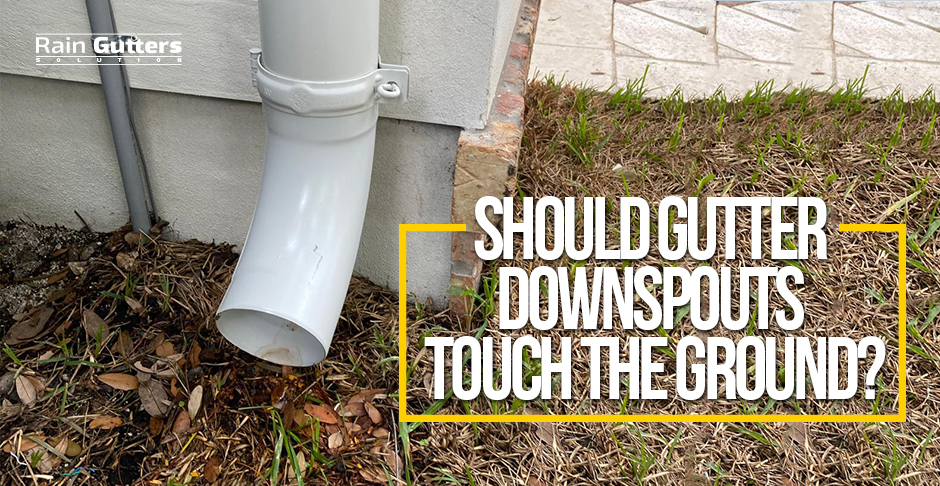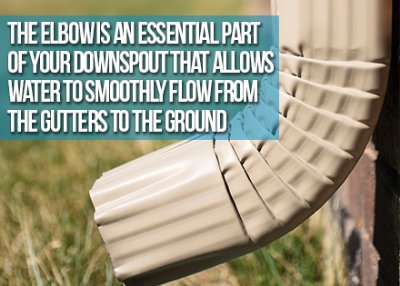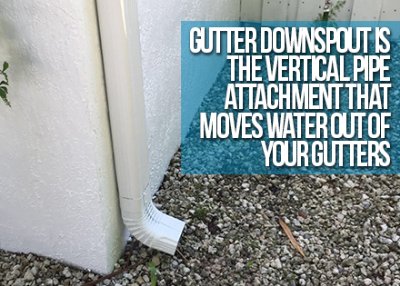Should Gutter Downspouts Touch the Ground?
February 17, 2022

There are many details going into the
Rain Gutter Installation process. One of them is figuring out the best placement for gutters and downspouts to guarantee you end goal: redirecting rainwater to a safe area, away from your property and its foundations. Your gutter's performance will be affected by the location and conditions of your downspout, which is why downspouts are seen as an extension of the gutter itself.
What's the Purpose of Having Gutter Downspouts?
Downspouts are at the heart of a home's outer drainage system. Basically, the gutters will lead all the water that rolls down your roof (either through rainfall, snow, or condensation) towards the downspouts. This way, you prevent the formation of pools of water around your foundations and on your property's soil. It also stops spills and water from dripping down your roof and soaking anyone who might be walking below the house.

Downspouts are easy to spot. They are attached to the ends of the gutters and run vertically from the roof's edge to the sides of the building. On the other end, you have extensions soldered to the downspout's bottom elbow that will drain all the water away from your home, usually to the city's main storm drains.
Installing Your Gutter Downspouts
There are a number of factors to consider when defining the placement of your downspouts. The slope of your land, for instance. Another factor is the length of your gutter.
In some cases, the building's layout makes it harder to adhere to the plan. Homeowners want to make sure their downspouts aren't in the way, and they don't want the downspout to be visible in a manner that could make the whole fašade look bad. This is one of the reasons why seeking a professional contractor may be the best choice to ensure there are no damages to your drainage system while coming up with a method that's esthetically pleasing in its results.
To know if gutter downspouts should touch the ground, let's look at all the installation requirements, listing the steps you need to follow during the process:
- Roofers recommend having a downspout for every 20 feet of guttering.
- Most homes have 1-2 downspouts in place, but if your area goes through bouts of heavy rain, getting more downspouts may be the best way to avoid an overflowing gutter.
- Map the route of the pipes to identify the water's path after it reaches the downspouts. Consider any slopes on the ground and the conditions of the soil.
- Your gutter downspouts should not touch the ground. Otherwise, the rainwater might get backed up in the gutter until it starts overflowing. The right way to do it is to have the downspout end at least 12 inches from the ground level, leaving enough room to pitch the extension at the base without disrupting the flow of water.
- If the building is located at the top of a slope, you don't have much to worry about. However, if you live at the bottom of a hill or in any other area where the land is low enough to risk floods, you need to work with the side of the building that withstands your downspout at a safe level while staying in line with the drainage system below.
- Have your gutter extensions run at least four feet away from your foundations to make sure the water is released away from your property.
As always, the process isn't over when you're done installing the gutter and downspouts. If you want to stop incidents that could hinder your drainage system, regular maintenance is essential. Check the inside of your guttering system at least once a week to catch any clogs in time, and flush out all outside elements (debris, branches, animal droppings, etc) using a bucket, a gutter scoop, and a hose.

What Do You Get from Your Rain Guttering System?
The main advantage of a proper rain guttering system is the ability to protect your foundations from corrosion and damage. As long as the downspouts are properly positioned toward the drainage area, you'll keep all the water away from your home during even the most intense storms, preventing the chances of floods on your basement and other common incidents, like rotting walls, soil erosion, etc.
On top of saving you from a pricy repair process, this will make a huge change in your daily life and expand the lifespan of many parts of your home. An efficient drainage system equipped with
custom-made gutters will also increase your home's market value, which will come in handy if you ever want to sell it for whatever reason.
About Downspout Drains
Downspout drains are usually buried from 12 to 48 inches below the ground to better conceal the drainage system. This also serves to avoid damage from rain and snow, and to leave the yard free of obstructions. While this is a common approach that's favored by many homeowners, there are things to consider.
First, not all homes have an expanse of land that homeowners can use at will without affecting neighbors. There are also local laws that could force you to alter your drainage route in order to avoid structural damage to the adjacent buildings. Last but not least, a downspout pipe will be undoubtedly harder to maintain when it's underground since you won't get easy access to any of its ends.
Before thinking of materials and tools, make sure to check your local regulations and run your plans by a professional contractor to find the safest option. A professional installation service is the best way to ensure the gutter and its downspouts work harmoniously.
Rain Gutters Solution guarantees an efficient installation, with all the resources to make your gutters match all your expectations. Our professional team can help you through any service when it comes to installation, replacement, maintenance, and repairs, so don't hesitate to come to us with your problem. You can call
(305) 270-7779 or fill out the
contact form on this website to schedule an appointment with us, and we'll provide the best service to help you protect your property.
If you found this article helpful then let us know in the comments section below. Likewise, feel free to share it using the share options below. Want us to cover another topic of your interest pertaining to rain gutters? If so, then like us and follow us on social media, and post to any of our social media profiles the topic you'd like us to discuss:
Facebook @RainGuttersSolution,
Twitter @Gutterssolution and
Instagram @RainGuttersSolution

 Downspouts are easy to spot. They are attached to the ends of the gutters and run vertically from the roof's edge to the sides of the building. On the other end, you have extensions soldered to the downspout's bottom elbow that will drain all the water away from your home, usually to the city's main storm drains.
Downspouts are easy to spot. They are attached to the ends of the gutters and run vertically from the roof's edge to the sides of the building. On the other end, you have extensions soldered to the downspout's bottom elbow that will drain all the water away from your home, usually to the city's main storm drains.